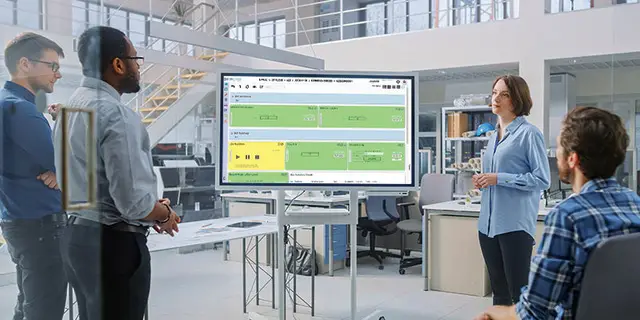Standard Implementation Model

Standard Implementation Model - Planning, Learning, Execution
With hundreds of successful deployments over more than two decades, AIMSCO-developed implementation methods have proven effective across a wide range of environments. In recent years, cloud-based collaboration together with advances in our no-code tools have enabled AIMSCO to extend these methods to safe, secure remote deployment support across the globe.
Remote virtual deployments minimize implementation costs while supporting client-driven continuous improvement. These deployments take place in a Standard Implementation Model with three primary stages: Planning, Learning, and Execution.
Planning
In Planning, client management and key users confirm objectives for initial deployment. Organization, location, and operational scope are defined. Target timing is set, with milestones, schedule and timing constraints noted. Roles, responsibilities, and task-level commitments are shared with a client core team. These include corporate / IT roles when ERP integrations are required, or plant staff for equipment / IoT connection.
Finally, the client’s Enterprise Services Portal (ESP) site is activated with links to training materials, test sites, and collaboration tools, providing secure access to the core team.
Learning
Depending on scope, Learning typically last from two days to two weeks. AIMSCO application engineers and the client core team join online for hands-on rapid prototyping sessions. Starting with simple eCheckItem types and expanding as needed to cover initial requirements, team members master the basics – and then the fine points – of eChecksheet authoring.
Feedback from end users throughout Learning, with regular reviews, ensures full coverage and ultimate acceptance. Importantly, these activities take place in a designated test sandbox separate from production, providing the freedom to learn safely.
Execution
For Execution, the main objectives are final test, end-user training, go-live and stabilization. Core teams originate site-specific end-user training, often embedded in the application as work instructions. Building on feedback during Learning, testing acts as an opportunity for training and final adjustments.
At go-live, applications and integrations are transferred from sandbox to production. End users begin capturing data with eChecksheets. Reports and other key outputs are available. A stabilization period where legacy entries continue is not uncommon, as the core team confirms all data flows. Issues are resolved in real time with close support from AIMSCO Enterprise Customer Services as needed.
From then, clients move into the Operate-Acquire-Analyze-Improve cycle. Daily operations and data acquisition ensure quality through built-in collaborative workflows and mistake-proofing. Data collected as a normal – and possibly automatic – part of daily operations power deep analysis, determining priorities for change. Improvements implemented in an efficient well-controlled manner are visible transparently across the enterprise. Waste is continuously reduced by engaged, empowered teams.